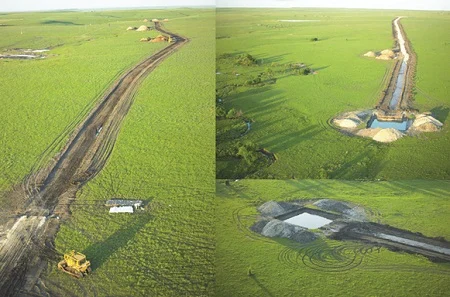Some environmental groups are somewhat (understandably) queasy about wind power development.
However, in a peer-reviewed study of the industry’s outlook and impact in Kansas, the local Nature Conservancy chapter concluded that “risks to wildlife from wind energy may be alleviated through proper siting and mitigation offsets.”

The researchers focused on protecting “key habitats (intact grasslands and playas); umbrella species (greater and lesser prairie-chickens); imperiled species (whooping crane); and areas of wildlife congregation that may be particularly vulnerable to wind energy impacts (bat roosts and playas).”
They also found that some areas would have to be completely avoided, but wind power could proceed in others areas without issue, and in others if “offset projects” were undertaken to make up for the ecological impact of the development.
According to the study, “conservation goals” could be met while putting to use 10.3 million hectares (ha) of Kansas – 48 percent of the state – for wind power generating. That would potentially yield 478 gigawatts (GW) of wind power capacity.
Even narrowing the focus to the 2.7 million ha that would require no compensatory mitigation could produce 125 GW of capacity – “1,648 percent higher than the level of wind development needed in Kansas by 2030 if the United States is to get 20 percent of its electricity from wind.”
The researchers proposed that projects that either avoid or offset impacts in line with the study could be given “Green Certification.” This, the authors said, “may help to expand and sustain the wind industry by facilitating the completion of individual projects sited to avoid sensitive areas and protecting the industry’s reputation as an ecologically friendly source of electricity.”
The study said wind power’s threats to wildlife include direct mortality to birds and bats as well as habit loss and fragmentation. It cited the case of the 150-MW Elk River Wind Project, near Beaumont, Kansas. There, it said, nearly 20 miles of new, improved roads (pictured above) were built across native tallgrass prairie to service the plant, “restricting movement for many animals, possibly leading to population level impacts and genetic effects.”
According to the latest quarterly report [PDF] from the American Wind Energy Association, Kansas is 14th in the United States in installed wind power capacity, with 1,074 MW, but government data indicates that it has vast potential, along with most of the U.S. Great Plains (see map above).
The full Kansas study, “Development by Design: Mitigating Wind Development’s Impacts on Wildlife in Kansas,” is available at the open-source peer-reviewed science site PLoS One.






